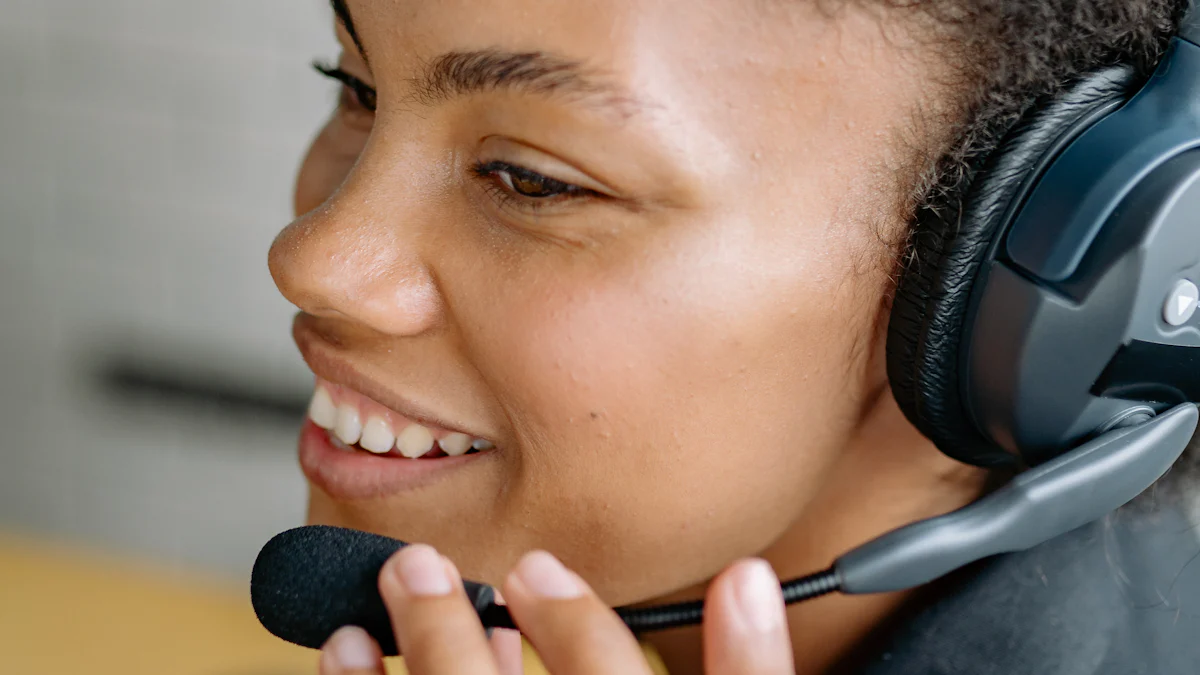Enhance Your Conference Calls with the Perfect Headset

In today's fast-paced world, conference calls have become a staple for both personal and professional communication. But how often do you find yourself struggling with poor audio quality? Background noise, echoes, and interruptions can turn a simple Zoom meeting into a frustrating experience. That's where a professional headset featuring a noise-cancelling microphone for conference calls comes in. By investing in the right equipment, you can significantly improve conference call quality. A professional headset featuring a noise-cancelling microphone for conference calls not only enhances audio but also boosts your confidence during video conferencing. Follow these steps to ensure your conference call audio is crystal clear, making every call productive and stress-free.
Understanding the Importance of Audio Quality
In the world of conference calls, audio quality plays a crucial role. You might not realize it, but poor audio can make or break your communication. Let's dive into why audio quality matters so much in conference calls and video conferencing.
Impact of Poor Audio on Communication
Imagine you're in a conference call, and the audio is choppy or filled with background noise. Frustrating, right? Poor audio quality leads to stress and disengagement. You might miss important details or feel excluded from the conversation. This can turn a productive meeting into a chaotic experience. reduce background noise
When audio quality suffers, so does your ability to communicate effectively. Misunderstandings become common, and you might find yourself repeating information. This not only wastes time but also affects the overall flow of the meeting. In video conferencing, poor audio can overshadow even the best visuals, making it hard for participants to stay engaged.
Benefits of High-Quality Audio
On the flip side, high-quality audio transforms your conference calls. It fosters a more engaged and interactive environment. With clear audio, brainstorming sessions become more effective, and creative problem-solving thrives. You can make better decisions when everyone hears and understands each other.
High-quality audio also boosts collaboration. Participants feel more connected and are more likely to contribute. This leads to more productive meetings and better outcomes. In video conferencing, good audio complements the visuals, creating a seamless experience.
To achieve this, consider using a single-ear (mono) headset. It can improve the audible quality of your calls and help you take more accurate notes. Small tweaks and troubleshooting tips can easily solve audio issues, ensuring your conference calls are smooth and stress-free. perfect headset
Choosing the Right Headset

Selecting the perfect headset can transform your conference call experience. With so many options available, it's essential to understand the different types and key features that can enhance your audio quality. Let's dive into what you should consider when choosing a headset for your conference calls.
Types of Headsets
Headsets come in various styles, each offering unique benefits for conference calls. Here's a quick rundown:
-
Over-Ear Headsets: These provide excellent sound isolation, making them ideal for noisy environments. The Jabra Evolve2 65 Flex is a great example, offering best-in-class active noise cancellation (ANC).
-
On-Ear Headsets: These are lighter and more portable. The JBL Live 670NC headphones deliver powerful JBL Signature Sound with True Adaptive Noise Cancelling, perfect for staying focused during calls.
-
Mono Headsets: If you prefer to keep one ear free, mono headsets like the Jabra Engage 50 II USB Mono Headset offer professional audio quality while allowing you to stay aware of your surroundings.
-
Stereo Headsets: For immersive audio, stereo headsets such as the Jabra Evolve2 30 SE UC Stereo USB Headset provide clear sound, enhancing your conference call experience.
Key Features to Consider
When choosing a headset, focus on features that will improve your conference call quality:
-
Noise-Cancelling Microphone: This feature is crucial for reducing background noise, ensuring your voice comes through clearly. The Jabra Evolve2 series is renowned for its noise-cancelling capabilities, keeping distractions at bay.
-
Comfort and Fit: Long conference calls require comfortable headsets. Look for adjustable headbands and cushioned ear cups to prevent discomfort during extended use.
-
Connectivity Options: Decide between wired and wireless headsets. Wired options, like the Jabra Evolve 20 USB Stereo Headset, offer stable connections, while wireless models provide more freedom of movement.
-
Compatibility: Ensure the headset is compatible with your devices. Many headsets, such as the Jabra Engage 50 II USB Stereo Headset, are designed for PC and Teams, making them versatile for various platforms.
-
Battery Life: For wireless headsets, consider battery life. You don't want your headset dying in the middle of an important conference call.
By understanding these types and features, you can make an informed decision that enhances your conference call audio. Remember, the right headset not only improves sound quality but also boosts your confidence and productivity during calls. So, take the time to choose wisely and enjoy a seamless conference call experience.
Tips for Using Headsets Effectively
Using a headset effectively can make a world of difference in your conference call experience. Here are some practical tips to help you get the most out of your headset.
Proper Setup and Configuration
Setting up your headset correctly is crucial for optimal performance. Follow these steps to ensure everything is configured just right:
-
Position the Microphone: Place the microphone close to your mouth, but not directly in front of it. This reduces the chances of picking up breathing sounds and ensures your voice is clear.
-
Adjust Volume Levels: Set the volume to a comfortable level. Too loud can cause distortion, while too soft might make it hard for others to hear you.
-
Test Your Audio: Before joining a call, test your audio settings. Most conferencing platforms offer a test call feature. Use it to check your microphone and speaker levels.
-
Use Built-in Software: Many headsets come with software that allows you to customize audio settings. Explore these options to enhance your listening experience.
-
Check Connectivity: Ensure your headset is properly connected to your device. For wired headsets, check the cable connections. For wireless ones, make sure they are paired correctly.
Maintenance and Care
Taking care of your headset will prolong its life and maintain sound quality. Here’s how you can keep your headset in top condition:
-
Clean Regularly: Wipe down the ear cups and microphone with a soft, damp cloth. This prevents dirt and oils from building up.
-
Store Properly: When not in use, store your headset in a case or on a stand. This prevents damage and keeps it dust-free.
-
Avoid Extreme Conditions: Keep your headset away from extreme temperatures and moisture. These can damage the electronics and affect performance.
-
Inspect for Wear and Tear: Regularly check for any signs of wear, such as frayed cables or loose connections. Address these issues promptly to avoid further damage.
-
Update Firmware: If your headset has firmware updates, install them. Updates can improve performance and fix bugs.
By following these tips, you can ensure your headset remains in excellent condition, providing you with clear and reliable audio for all your calls. Remember, a well-maintained headset not only enhances your communication but also contributes to a more professional and stress-free conference call experience.
Additional Tips for Enhancing Call Quality
Enhancing call quality goes beyond just having the right headset. Your environment and call management practices play a crucial role too. Let's explore some additional tips to ensure your conference calls are as smooth and productive as possible.
Optimizing Your Environment
Creating an optimal environment for your calls can significantly improve audio quality. Here are some practical steps you can take:
-
Designate a Quiet Space: Choose a quiet area for your calls. This minimizes background noise and distractions, allowing for clearer communication. If possible, use a room with a door that can be closed to block out external sounds.
-
Use Acoustic Panels: Consider installing acoustic panels in your workspace. These panels absorb sound and reduce echo, enhancing the clarity of your audio. They are especially useful in rooms with hard surfaces that can cause sound to bounce around.
-
Control Lighting: While audio is crucial, don't forget about lighting. Use additional lights to ensure your face is well-lit during video calls. Avoid big light sources behind you, as they can create shadows and make it difficult for others to see you clearly.
-
Position Your Microphone Correctly: Adjust your headset microphone to the right position. It should be close to your mouth but not directly in front of it. This reduces the chances of picking up breathing sounds and ensures your voice is transmitted clearly.
Best Practices for Call Management
Effective call management can also enhance the quality of your conference calls. Here are some best practices to consider:
-
Test Your Equipment: Before starting a call, test your headset and microphone. Click the volume settings on your device to ensure everything is working correctly. This simple step can prevent technical issues during the call.
-
Mute When Not Speaking: Mute your microphone when you're not speaking. This prevents background noise from disrupting the call and keeps the focus on the current speaker.
-
Use Headset Controls: Familiarize yourself with your headset's controls. Many headsets have buttons for muting, adjusting volume, and answering calls. Knowing how to use these features can make your call experience more seamless.
-
Prioritize Audio Over Video: In low bandwidth environments, prioritize audio over video. Clear audio is critical for effective communication, especially when network conditions are challenging. You can always turn off your video if it helps improve the audio quality.
-
Stay Organized: Keep a notepad handy to jot down important points during the call. This helps you stay engaged and ensures you don't miss any key information.
By optimizing your environment and following these call management practices, you can enhance the quality of your conference calls. Remember, clear communication leads to more productive meetings and better outcomes. So, take these additional steps to ensure your calls are as effective as possible.
Choosing the right headset can transform your conference calls. It enhances audio quality and boosts your confidence. By applying the tips and strategies discussed, you can enjoy a seamless communication experience. Investing in a quality headset, like the Jabra Evolve2 or Coolpo Ignite, offers significant benefits. These headsets block distractions and improve productivity. As one user noted, a good headset can make even a noisy environment feel quiet and comfortable. So, take the leap and invest in a headset that elevates your professional communication.
See Also
Exploring My Quest for the Perfect Meeting Room Camera
Selecting the Best 360-Degree Camera for Your Meetings
Finding the Right Webcam for Huddle Room Conferences
Upgrade Your Virtual Meetings with a 4K Auto-Tracking Webcam
